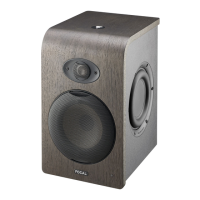
Do you have a question about the Focal SHAPE and is the answer not in the manual?
| Frequency Response | 40Hz - 35kHz |
|---|---|
| Tweeter | 1" (25mm) Al/Mg inverted dome |
| Amplification | Class AB |
| Inputs | XLR, RCA |
| Type | Active Studio Monitor |
| Construction | MDF cabinet |
| Finish | Walnut Veneer |
Critical warnings about electrical shock, opening the unit, and avoiding water or moisture exposure.
Essential safety guidelines for user operation, including manual retention and cleaning methods.
Clarification of warning symbols indicating high voltage and important instructions for safe use.
Steps to connect the audio source, check voltage, and power on the loudspeakers.
How the loudspeakers enter and exit 'Standby' mode via audio signal detection.
Recommended order for switching off the loudspeakers and audio sources.
Description of the SHAPE 40 professional nearfield monitor loudspeaker, its components, and features.
Description of the SHAPE 50 professional nearfield monitor loudspeaker, its components, and features.
Description of the SHAPE 65 professional nearfield monitor loudspeaker, its components, and features.
Importance of ground connection using the supplied power cord for safe operation.
How to connect audio sources via XLR and RCA, including wiring schemes.
Explanation of the 'Standby' mode, its activation, and power consumption when idle.
Recommendations for nearfield monitor placement, height, and orientation for optimal soundstage.
How to use adjustable spikes for mechanical decoupling and vertical orientation adjustment.
Recommended placement for stereo listening to form an equilateral triangle with the listener.
Optimal loudspeaker placement for a 5.1 surround sound system for equidistant listening.
Method for adjusting loudspeaker height using decoupling spikes for optimal listening position.
Importance of a running-in period for transducers and recommended usage for stabilization.
Details on connecting balanced signal sources via XLR, including pinout and sensitivity.
Details on connecting unbalanced signal sources via RCA, including wiring and sensitivity.
Explanation of the HPF control and recommended settings for different configurations and room acoustics.
How the ON/OFF switch controls power and triggers 'Standby' or 'On' mode.
How to adjust low-frequency response using the LF shelving potentiometer based on room acoustics.
How to apply low-mid frequency correction at 160Hz using the LMF EQ potentiometer.
How to adjust high-frequency response using the HF shelving potentiometer based on room acoustics.
Location and use of the power cord connector on the rear panel.
Information on attachment points and compatible kits for wall or ceiling installation.
Details on fastening points for mounting loudspeakers on stands, including format type.
Explanation of the front panel LED indicators for power, standby, and signal detection.